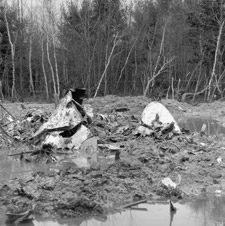Air
In the preface of her book Hurricane Hazel, Betty Kennedy (1979, vii-viii) refers to the importance of remembering and retelling of disasters as a way of reaffirming life:
For a time it puzzled me that so many individuals who had personally met disaster should be able to go back and relive it. Gradually I came to feel that in a curious and complex way, their retelling did many things: it was at once a way of saying, "Yes, I remember," and "We have been able to survive." And it was also a way of expressing a never-ending wonderment at the life force that is in us all. The remembering is a reaffirmation of life.
The disaster stories remembered in this section are similar in that they tell of horrific damage and loss of life. They also tell however, of the determined spirit of those who survived to rebuild their lives. This rebuilding was often with the help of strangers, in addition to family and friends.

Source
Regina after the tornado, June 30, 1912
Regina's tornado occurred in 1912, when the city (and the Province of Saskatchewan for that matter) was quite new and perhaps less equipped to deal with a disaster of this magnitude. There were fewer conveniences such as telephones, flashlights and vehicles -- conveniences that were taken for granted by mid-century.

Source
Debris at the airplane crash site, Ste-Thérèse-de-Blainville, Quebec, November 1963
When Hurricane Hazel hit Toronto in 1954, the rarity of a hurricane wreaking havoc in the interior of Canada took both the authorities and the population at large by surprise, and left a high death toll in its wake.
The Trans-Canada Airlines crash of 1963, in Montréal, was not exactly related to bad weather but instead had more to do with faulty equipment. The heavy rainfall that preceded the crash, and the snowfall afterwards, however, did play an important role in the inability to come to a definite conclusion regarding the cause of the crash.
These three events are certainly not the only Canadian disasters pertaining to "air" that have occurred over the years. A powerful and devastating tornado hit Edmonton on July 31, 1987, killing 27 people, injuring 600 and leaving 1,700 homeless, with an estimated total cost of over $665 million. While tornadoes are not unusual events on the prairies, the magnitude of the loss of life and damage of this tornado were particularly severe; over a 100-year span beginning in 1879, seven tornadoes have hit the Edmonton region, killing a total of 22 people.
Likewise, hurricanes are not rare on the east coast of Canada. In 2003, Hurricane Juan left behind devastating damage and multi-day electrical blackouts in Halifax and other areas of Nova Scotia and Prince Edward Island. At least seven people were killed. Another hurricane that struck the Maritimes in June 1959 left 33 people dead.
And, of course, there have been other accidental Canadian plane crashes. An Air Ontario F-28 passenger plane crashed near Dryden, Ontario in 1989, killing 24 people and injuring 45. In December 1956 a Trans-Canada Airlines North Star disappeared outside Vancouver, en route to Calgary, with 62 people on board. That plane was not found until May 1957, when it was discovered on Mount Slesse, B.C.